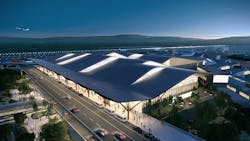Pittsburgh International Airport’s New Modernized Design Will Create Better Traveling Experience
Officials at the Pittsburgh International Airport (PIT) have unveiled the design for a $1.1 billion modernization of a new terminal to join the growing Pittsburgh region. It is based on a philosophy of nature, technology and community, and is being developed by the joint venture of architectural and engineering firms Gensler and HDR, along with luis vidal + architects.
The firms were awarded the design contract in July 2018 after the Federal Aviation Administration (FAA) approved their master plan, and have since been studying the Pittsburgh region.
Listen to our Pittsburgh International Airport Podcast coverage
Your browser does not support the audio element.The design for the new terminal, scheduled to open in 2023, takes inspiration directly from the area’s rolling hills and rivers, neighborhoods and communities, and new economic diversity that has led to Pittsburgh’s re-emergence over the past few decades.
Benefits of Design for Passengers
Noteworthy goals for the project, known as the Terminal Modernization Program (TMP), include reducing the time it takes to get from curbside to airside by 50 percent and improving the passenger experience from curb to gate by creating a “wow” effect.
The concept design, while subject to change, currently features the following:
- Separate levels for departing and arriving passengers and a non-public level for building systems such as baggage belts
- Additional space for an expanded TSA checkpoint
- Shorter walking distances for arriving and departing domestic and international passengers
- Indoor and outdoor green plazas and gathering spaces
- Additional space for concessions, artwork and other amenities
- Planning for technological improvements and more automated systems
- Emphasis on sustainability
The current facility was built for connecting passengers and is not ideal for today’s busy travel market, especially considering that PIT has seen four straight years of passenger growth. In 2017, the airport finished with nearly 9 million passengers, the most in a decade.
Those looking to travel to the Pittsburgh region in the near future can use a variety of travel sites to help plan their trip in a few simple steps, such as Cheap Air or TripAdvisor—both of which allow you to book flights, cars and hotels or rentals.
Quantifying the Impact of Design
The TMP will consolidate landside and airside operations into one connected, adaptable facility. So, how will this impact the surrounding community? Here are some key facts and figures.
- 11,000 direct and indirect jobs for the region
- $1.66 billion generating in economic activity
- 3x the amount of covered parking
- 2x the square feet at security checkpoints
- 50% reduced time to get from curb to airside
- 40 years extended on to the life of the facility
- 1 level change from curb to gate
Learn more about PIT’s new terminal design on I Hear Design, where I and architect Luis Vidal discuss the project’s design philosophy, nicknamed NaTeCo.
More Design News | A Colorful, Eclectic Spin on Train-Station Dining
This article was originally posted on 02/27/2019 and updated 07/22/19
About the Author

Adrian Schley
Associate Editor
Adrian Schley was an Associate Editor for i+s, where she covered the commercial interior design industry since 2018. Her work can also be found in BUILDINGS and Meetings Today.
